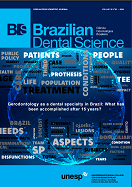Psychosocial impact of dental aesthetics among sudanese high school students.
DOI:
https://doi.org/10.14295/bds.2016.v19i2.1225Abstract
Objective: Dental aesthetics essential part of facial attractiveness, plays a vital role in the social as well as the psychological well being of individuals. This study aimed to assess the level of dental aesthetics by the self-rated Aesthetic Component (AC) of the Index of Orthodontic Treatment Need (IOTN) and the psychosocial impact of dental aesthetics using the ‘Psychosocial Impact of Dental Aesthetics Questionnaire’ (PIDAQ). Material Methods: A total of 192 high school students (13-16 years old), genders equally participated in the study and completed a modified version of the ‘Psychosocial Impact of Dental Aesthetics Questionnaire’ (PIDAQ). Dental aesthetics were assessed by the IOTN Aesthetic Component (self-rated IOTN-AC). The data was processed and analyzed using computer software program “SPSS” (Statistical Package for Social Sciences) version 17. T-test has been used, P-value of less than 0.05 was considered as significance. Results: All the variables of the PIDAQ showed a significant difference with the groups of the IOTN-AC (P-value < 0.05). Inter-gender significant difference was found among the students. Conclusion: Self-perceived dental aesthetics has a strong influence on the psychological as well as the social wellbeing of individuals. Therefore self-perception of dental aesthetics maybe an important key in deciding the orthodontic treatment need.
Keywords:
Dental aesthetics; Psychosocial impact; Malocclusion; IOTN; Students.
Downloads
Downloads
Published
How to Cite
Issue
Section
License
Brazilian Dental Science uses the Creative Commons (CC-BY 4.0) license, thus preserving the integrity of articles in an open access environment. The journal allows the author to retain publishing rights without restrictions.
=================




























